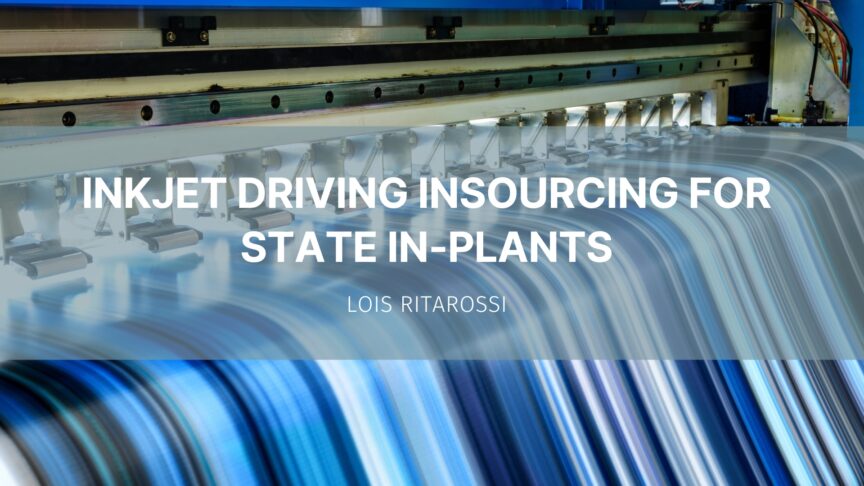I recently spoke with two respected in-plant managers running sizable operations in their respective states. Kristen Hampton is the Division Director, Department of Technology Management & Budget, for the State of Michigan, and Tim Hendrix is the State Printer, state of Oregon Publishing & Distribution.
Hampton and Hendrix are both running fully digital shops, with a mix of inkjet and toner devices on continuous feed (CF) and cutsheet platforms. Hampton’s inkjet journey led to the elimination of offset printing. Hendrix’s recent inkjet installation is driving operational efficiency. They shared their perspective on staffing, operational cost, inkjet as an enabler and considerations for future investments.
Operational Efficiency is the Goal
Hampton has tasked her team with improving efficiency throughout their production process. Her operation has both cutsheet and CF inkjet devices in addition to toner. Her team installed cut sheet inkjet to complement their CF inkjet platform and replace their offset press in 2020. Hampton manages a team of 65 providing, print, mail, and distribution services.
Hendrix installed CF inkjet one year ago which replaced CF toner. His goal for 2024 is further optimization by moving more work from toner to inkjet. His team is thrilled with the uptime and throughput from their Ricoh VC 60000 platform. Hendrix manages a team of 86 full-time employees for print, bindery, mail, shipping, administration, and shuttle delivery services.
Staffing challenges lead to workflow automation
Hampton’s team experienced many retirements during the pandemic. She is still challenged in finding dependable employees with the necessary skills for entry level jobs. As a result, Hampton’s operation is identifying new equipment and software to automate more steps in their production process. The goal for the team is to increase throughput of finished pieces.
Hendrix has had some success with hiring younger workers in the last two years. In the last six months he is struggling to find qualified candidates for entry level jobs. In the greater Portland Oregon area Hendrix is finding private sector jobs have higher starting pay rates. In a recent article I wrote about other in-plant managers and the strategies they adopted to address staffing challenges.
Inkjet enablement
Inkjet adoption means changing from a cost-per-click model for color to overall ink consumption. Hampton and Hendrix have analyzed color volumes and ink usage to educate their customers on the opportunity to use color at nearly the same price as black and white.
Hendrix has worked closely with one of his large state agencies to increase adoption of color. The result is 70% of jobs are now run as color applications, compared to 9% before they installed inkjet. The newly designed color documents are often mailed to recipients from underserved communities. Color provides increased readability and generates increased response.
Hendrix has also streamlined production with inline perforation. Inline capabilities have eliminated the need for higher costs for perforated stock, inventory management and pre-printed shells. The operation is more efficient with fewer manual steps and stocks to manage.
The Ricoh Pro VC60000 is the first press in the Oregon operation that does not have a redundant back-up. Based on the size of the investment and average throughput they installed one line. The backup plan includes the ability to move jobs to toner cut sheet if necessary. The inkjet platform has delivered remarkable speed and uptime. They planned a cost-benefit justification based on moving 40% of their jobs to inkjet. In just one year they have moved 65% of their work to inkjet providing a significant reduction in overall operational cost. I wrote about other in-plant managers and their inkjet journeys in this recent article.
Future investments
Hendrix is investing in additional workflow automation for on-demand jobs to streamline job management and billing from RSA WebCRD to production and Avanti Slingshot. His goal is fewer manual touch points for his team. Hendrix is also planning to expand mail services with new capabilities in the next 24 months.
With their inkjet platform, Oregon’s in-plant can now provide more than a transactional print focus. They are assisting state agencies with higher quality jobs, including perfect and coil bound books that were previously outsourced.
Hampton is in the process of upgrading her current cut sheet inkjet and considering a B2 size press with increased stock flexibility. Building upon their success with inkjet, Hampton sees adding B2 inkjet capabilities as the next logical step to better serve state agencies. A B2 size press will allow her to insource many jobs running on offset and provide higher image quality with shorter turnaround at a lower cost. The priceless triple win.
Inkjet has delivered on the promise to streamline production and reduce overall costs compared to offset and toner. Hendrix and Hampton are committed to continuous learning as part of effective management of their operations. They conduct ongoing communications and updates with the major equipment and software providers to stay abreast of product changes and new technologies.
Lessons learned
Success with inkjet is the result of detailed planning and cost analysis from multiple perspectives. Validating the necessary changes for infrastructure by working closely with your equipment manufacturers to evaluate options for site prep, electrical, HVAC, and ventilation will provide a plan for success. Read more about inkjet success for PSPs here.
The next critical step is a thorough workflow analysis with consideration for automation at every step in the workflow. Evaluating every digital and physical workflow step and touch point will inform the best decisions for automation. Consider the best options for in-line and near line finishing for overall workflow improvements. Inkjet solutions with optimized workflow mean less touchpoints, less material handling, fewer errors and rework. Workflow done right enables improved time to finished products and happier customers.

